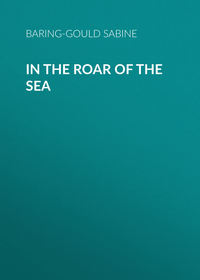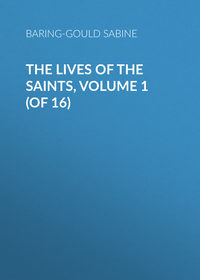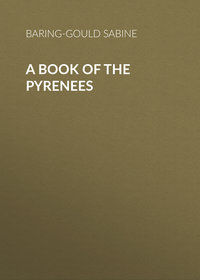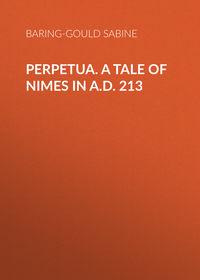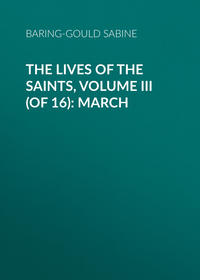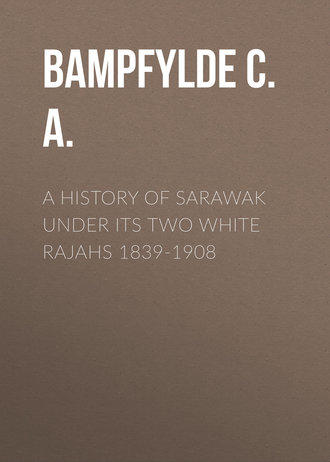 полная версия
полная версияA History of Sarawak under Its Two White Rajahs 1839-1908
72
Son of the late Sir Hugh Low, G.C.M.G. He served in the Sarawak Civil Service from 1869 to 1887, in which year he died. His knowledge of the natives, their languages, and customs, was unsurpassed. The notes he left formed the basis of Ling Roth's work, The Natives of Borneo, 1896.
73
This was the serah, or forced trade formerly in force in all Malayan countries; and it appears to be still so, in a modified form, in Sumatra.
74
The Sarawak Malays were also so forced to mine by Pangiran Makota, and this forced labour was one of the principal causes of the rebellion of 1836-40 against the Sultan's Government.
75
This happened after this man had been banished by the late Rajah from Sarawak. See Chap. III. p. 87, for the fate he met and so richly merited.
76
Famous in Malay legends throughout the East as Nakoda Ragam, a renowned sea rover and conqueror.
77
W. P. Groeneveldt, Essays relating to Indo-China, 1887.
78
Camoen's Lusiad (Sir Richard Burton's translation.) Camoen here refers to the islands of the Malayan Archipelago, which he visited in his exile some 350 years ago.
79
St. John tells us that a few years before this an English ship that had put into the Sarawak river to water was treacherously seized; the Englishmen were murdered, and the Lascars sold into slavery.
80
Anglice, cat.
81
A short time before the commencement of this history this place had been attacked by the Saribas Dayaks, and 120 people were slain.
82
3000 feet.
83
Spencer St. John, Sir James Brooke, 1879.
84
Mr. Brooke. He was a good-looking man. Capt. the Hon. H. Keppel gives his portrait, the frontispiece to vol. i. of his Expedition to Borneo of H.M.S. Dido, which is incorrectly entitled the portrait of Rajah Muda Hasim.
85
Spelt Sahib by Mr. Brooke in his letters and journals, and by others, but correctly his name was Sahap. He had a reputation for bravery, and was styled by the Sekrang Dayaks "Bujang Brani," the brave man.
86
There is no strict law of primogeniture in Bruni, otherwise Rajah Muda Hasim could not have been heir-presumptive. As he was of royal blood, and the prince most fitted to succeed, he was looked upon as the heir to the throne, and was so acknowledged (publicly in 1846) by the Sultan, and was therefore more correctly heir-apparent. At this time Sultan Omar Ali had two sons, and the eldest, also named Hasim, must have been about thirty-five years of age. There was a disgraceful harem scandal in connection with their birth, which pointed to their having been the sons of a Nakoda, or merchant. Though this appears to have been generally credited, Hasim nevertheless became the 24th Sultan in 1885.
It may be noted here that Omar Ali himself was only de facto Sultan, as he was never able to obtain the legal investiture which in Bruni constitutes an election to the throne de jure, and which confers upon the sovereign the title of Iang de Pertuan, the Lord who rules, the most exalted title, and one which he never assumed.
87
Or an abbreviation of Muhammad Husain. In former works he is incorrectly styled Moksain (for Matsain), following Mr. Brooke's published letters and journals, which were badly edited in regard to native names and words.
88
Mr. Brooke.
89
Mr. Brooke.
90
The Bruni, not the Sarawak Malays.
91
Mr. Brooke.
92
Idem.
93
By which he was generally referred to, both in documents and verbally, by the Malays of Bruni and Sarawak. "Rajah of Sarawak" was a complimentary title given to him by Europeans only. He has been frequently styled Muda Hasim by former writers; this would be unintelligible to a Malay.
94
Such was this ascendency that they became the founders of the present ruling dynasties of Bruni (Chap. II., p. 1), Palembang (Sumatra), Pontianak, Sambas, Mindanau, and Sulu, and probably of other native states.
95
Land-Dayaks.
96
Shortly before Rajah Brooke's arrival, Sherip Sahap with a large force of Sekrang Dayaks had attacked the Sau tribe of Land-Dayaks in Upper Sarawak. Many were killed, their villages plundered and burnt, and nearly all the surviving women and children, to the number of some two hundred and fifty, carried off into slavery. The Rajah eventually recovered nearly all.
97
Meaning Rajah Muda Hasim.
98
Bruni.
99
Duit, Malay for a cent.
100
Rajah Brooke.
101
"I admit that Bruni has its points, but what irony to compare for a moment the city of marble palaces with the mass of miserable huts which a single match could easily reduce to ashes." – Beccari, op. cit. The Rajah called the place a "Venice of hovels." Mercator in his Atlas describes it as "being situated on a saltwater lagoon like Venice," hence probably it became known as the Venice of Borneo.
102
Kota batu, stone fort. The name still remains. It was built towards the close of the fifteenth century by Sherip Ali, the first Arab Sultan, with the aid of the Chinese subjects his wife's mother had brought to Bruni. The city was then nearer the mouth of the river. It was moved to its present position by Sultan Muadin about 200 years ago.
103
Magellan, Hakluyt Society, and the Portuguese Jorge de Menezes, who visited Bruni five years after Pigafetta, notices that the city was surrounded with a wall of brick, and possessed some noble edifices. Other early voyagers describe the sultans and rulers of Malayan States as maintaining great style, and their equipments, – such as swords of state, saddles, chairs, eating and drinking utensils – as being of pure gold. Allowing for some exaggeration, this would still point to a former condition of prosperity which enabled rulers and nobles to keep up a pageantry which has long since vanished.
104
This malformation, according to the laws of Bruni, would have disqualified him for the throne, for these provide that no person in any way imbecile in mind or deformed in person can enjoy the regal dignity, whatever title to it his birth might have given him. – Sir Hugh Low, op. cit. p. 108.
105
Saya, or more correctly, sahaya (mis-spelt suya in the Rajah's badly edited journals) is the Malay for I, mine; so amigo saya would be, My friend. Amigo was one of the few Spanish words the Sultan had.
106
Established in 1855.
107
Afterwards Admiral of the Fleet. He died, January 1904.
108
The Governor-General of Netherlands East Indies in a rescript, dated January 23, 1846, acknowledged that the exertions during the past twenty-five years effectually to suppress piracy on the coasts of Borneo had not been successful for want of combination, and for having been limited to the western coast.
109
A Collection of Voyages, 1729.
110
Sulu was the principal market for the disposal of captives and plunder.
111
A son of Captain Francis Light, who founded Penang in 1786, was named Lanoon, he having been born on the island at the time it was being blockaded by Lanun pirates.
112
Dayak war-boats, some having as many as 75 to the crew.
113
Expedition to Borneo of H.M.S. Dido, 1847.
114
On behalf of the Sultan, Saribas and Sekrang being beyond Rajah Brooke's jurisdiction.
115
Keppel, op. cit.
116
These Sea-Dayaks, together with those of the Undup, also an affluent of the Batang Lupar, subsequently became the mainstay of the Government against the Saribas and Sekrangs.
117
Life of Sir James Brooke, p. 84.
118
Sir Edward's report upon Sarawak appears to have been favourable; he pronounced the coal at Bruni, which he never examined, to be unworkable, and the Sultan to be a savage.
119
Pronounced by the natives Achi.
120
More correctly Putusan, or Pemutus. We retain the old spelling.
121
These guns realised £900 at public auction in Singapore.
122
The Patinggi was always ready and ever to the fore where tough work and hard knocks were going, and he was the guiding and leading spirit in such expeditions as was this. "Three fingered Jack" the Dido's crew had dubbed him, having that strong regard for him that brave men bear towards another though his skin be of a different complexion – for he had lost two fingers in a former encounter. The type has since changed, and the courtly, intrepid, and determined fighting Malay chief has gone – and he is missed. "I sigh for some of the old hands that could not read or write, but could work, and had more sound wisdom in their little fingers than many popinjay gentlemen of the present day carry in their heads," so wrote the present Rajah ten years ago.
123
Mr. George Steward, formerly of the H.E.I.C.'s maritime service, had been sent out by the Rajah's agent, Mr. Wise, on a trading venture. He joined the expedition as a volunteer, and had concealed himself in Patinggi Ali's boat, where he should not have been.
124
Keppel, op. cit. We have taken our account of the expedition up the Batang Lupar mainly from Keppel's narrative, the only original history of these operations hitherto published.
125
He was afterwards pardoned and permitted to reside at Sekrang town, where he died.
126
Labuan, however, proved a failure as a trading centre, and in that respect has taken a very secondary position to Kuching.
127
Journals, Keppel, op. cit.
128
The pirates and their supporters, however, preyed upon Islams as well as infidels, and religion was a dead letter to them in this respect. Quite contrary to the tenets of their faith, true believers who were captured were sold into slavery.
129
The son of Sherip Japar. S. Japar died the following year.
130
He was married to a niece of Datu Patinggi Gapur.
131
His son Haji Usup joined the Government service in 1862, and was afterwards appointed Datu Bandar in the Rejang. He died April 1st, 1905, after having served the Government faithfully and with distinction for over forty years. As a magistrate he bore a high reputation.
132
The ring Bedrudin sent had been given him before he left Sarawak by the Rajah, who told Bedrudin to send it to him when he had need of him; it was seized by the Sultan before Japar escaped from Bruni.
133
He meant Bruni, which he had hoped to have restored to its former state of prosperity.
134
Reports had been published that the Rajah was closely besieged in Kuching by the Sultan's forces.
135
The foregoing details are mainly taken from Mundy's Rajah Brooke's Journals. The captured cannon were sent to England. St. John says some were melted up to construct cannon for the Crimea. —Forests of the Far East Brunis were famous brass-founders, and many of these guns must have been very old.
136
Private Letters of the Rajah.
137
His son, the Pangiran Muda, is still alive in Bruni.
138
The tribute was cancelled by the release of a debt due to the Rajah by the Sultan, the interest upon which was equivalent to the yearly tribute.
139
Though this deed bore the seal of Pangiran Abdul Mumin, he confirmed it by another granted in 1853, after he had become Sultan. Only copies, attested by H.M.'s Consul-General, exist now, the originals, together with the two previous grants, having been burnt during the Chinese rebellion of 1857.
140
Letter to the Earl of Clarendon, September 27, 1853.
141
Captain Mundy said truly of the Rajah that he was the de facto sovereign of the whole coast of Borneo from point Api (he should have said Cape Datu) to Marudu, 700 miles in extent.
142
The territory of Sarawak then extended to Cape Kedurong.
143
Mundy, op. cit.
144
From Blue Book, March 2, 1854.
145
Private Letters.
146
Letter from the Rajah to the Tuan Muda, 1864.
147
From Mundy, op. cit.
148
Of these, three foundered from injuries received during the engagement, so that few returned home to tell the tale. It took the Balenini about fifteen years to forget the lesson. —Sir James Brooke, St. John.
149
Mundy, op. cit.
150
Private Letters.
151
He joined the Rajah in March, 1843, having previously served in the H.E.I. Co.'s Navy, and became Police Magistrate and Government Secretary. In 1863 he was appointed Resident of Sarawak. He frequently administered the Government during the absences of the late and the present Rajah. He retired in 1873, and died in 1891.
152
The warrant of investiture was issued by her Majesty on May 22, 1848.
153
Amongst others who came out with the Rajah in the Mæander were Mr. Spenser St. John, afterwards Sir Spenser St. John, G.C.M.G., the Rajah's Secretary; and Mr. Hugh Low, afterwards Sir Hugh Low, G.C.M.G., Colonial Secretary at Labuan. Mr. St. John was Consul-General at Bruni from 1853-1861; he left Borneo the latter year upon promotion. Mr. Low had before spent some three years in Sarawak botanising. He left Labuan in 1877, when he was appointed Resident of Perak.
154
The eldest son of the Rev. Francis Charles Johnson, Vicar of White Lackington, Somersetshire, by Emma, the Rajah's second sister.
155
Yellow ground, with black and red cross, as shown in illustration – the arms of the Brookes. The Government flag is distinguished by a crown in the centre; the Rajah's flag is a burgee, or swallow-tailed flag.
156
Keppel, Voyage to the Indian Archipelago.
157
Private Letters.
158
Of his fifteen sons, Abangs Apong, Chek, Tek, and Bunsu all served the Government afterwards; they were distinguished more for bravery than for rectitude, but they were faithful and useful servants. Another son was killed during the operations up the Saribas subsequent to the action of Beting Maru. The Laksamana lived for years after these events, and was about ninety when he died.
159
Keppel, op. cit.
160
The plains on both banks of the river evidence a former cultivation on an extensive scale.
161
St. John, Life of Sir James Brooke.
162
An army in Malay and Dayak.
163
Afterwards Admiral Sir Arthur Farquhar, K. C. B. He died in 1908, aged ninety-three.
164
Anglice, King Lion.
165
Beting Maru is the name of a long sand-spit running into the sea between the Kalaka and Saribas rivers off the Maru river.
166
This same Linggir in 1845 attempted to murder the Rajah and his officers and other English guests whilst at dinner in the Rajah's house at Kuching. He marched into the dining-room with eighty armed men, pretending to pay a friendly visit. The Rajah and his guests adopted the only policy open to them, and pretended as well to be friendly, for they were completely at the mercy of the Dayaks. They entertained their unwelcome guests with wine and cigars whilst waiting for the Datus, to whom the Rajah had contrived covertly to send a message. The Datu Temanggong arrived first with thirty men, and then came the Datu Bandar with fifty men. The Datus wished to kill Linggir for his intended treachery, the Rajah, however, spared him, perhaps unwisely, but he had to slink away to his boat with a flea in his ear. He had actually brought with him a basket to contain the Rajah's head. He afterwards became a peaceable citizen, and very friendly to the white men.
167
These unfortunate girls, and those taken at Matu, were barbarously murdered by the pirates to prevent their being rescued.
168
Or better, Mashhor, an Arabic word meaning illustrious.
169
Mr. W. Brereton first came to Sarawak in the Samarang, as a midshipman, in 1843. In 1848 he left the Navy and joined the Rajah. He was first stationed at Labuan. He was only twenty years of age when appointed to take charge of Sekrang.
170
The Sekrangs lost heavily at the battle of Beting Maru.
171
Private Letters.
172
Private Letters.
173
To show how these charges were supported by wilful and gross exaggerations, that could only have been made for the express purpose of deceiving the public, and which were as ridiculous as they were mischievous, Hume stated that it was doubtful whether a portion of the Royal Navy of China, which was reported to be off the coast at the time for the purpose of making peace with these people (the Saribas and Sekrangs), had not been destroyed by the expedition!
174
Keppel, Voyage to the Indian Archipelago.
175
The important fact that in all their marauding expeditions the Saribas and Sekrang Dayaks were mixed up with the Malays of the Saribas and Batang Lupar, who not only commanded and led them, but accompanied them in large numbers seems to have been quite overlooked by both the Rajah's accusers and his supporters. This in itself is a sufficient indication of the piratical nature of these expeditions. The character of these Malays as pirates was at least beyond question, and to assert that they went with these poor "harmless and timid" Dayaks to assist them in their intertribal feuds would be a very wide stretch of imagination. We have shown that the force routed on Beting Maru was led by Malays.
176
Married to a daughter of the Datu Patinggi Gapur. He was afterwards selected by Sherip Masahor's party to murder the present Rajah, but the task was not to his liking.
177
From Life of Sir James Brooke, St. John.
178
May 1850, 145 to 20; June 1850, 169 to 29; July 1851, 230 to 19.
179
The Rajah to Lord Clarendon, December 25, 1853.
180
John C. Templar, Private Letters of the Rajah, v. iii. p. 117.
181
Private Letters.
182
The Dutch Resident of Western Borneo, not of Sambas only. He certified that on one raid the Saribas and Sekrangs killed four hundred people on the Dutch coast. Referred to by Earl in his Eastern Seas; he relates that the Dayaks swept the whole coast from Sekrang to Sambas, killing the entire population of Selakau. As far back as 1825, the Resident of Sambas (Van Grave) and his secretary were killed on their way to Pontianak in a small vessel. Keppel tells us the Saribas once laid in wait for "the (Dutch) man-of-war schooner Haai, and in one engagement killed thirty-seven of the Dutch, losing eighty of their own force." Keppel's book, A Voyage to the Eastern Archipelago in 1850, contains an able refutation of the charges made by Hume and Cobden.
183
The foregoing particulars are taken from Mr. Prinseps' report, dated January 6, 1855.
184
From Mr. Devereaux's report.
185
Son of the late Admiral Sir Thomas Cochrane.
186
The Land-Dayaks.
187
This is now the established title of the second sons of the Rajahs.
188
Now the Right Hon. Sir John Dalrymple Hay, Bart., P.C.
189
Pangiran Matali (Muhammad Ali) was a brave man, honest and faithful. He was a Government chief and magistrate, and his death, a few years ago, was felt as a severe loss. He had a very thorough knowledge of the Dayaks, and was a capable man in handling them. He was a prince by birth of the royal blood of Bruni. He stands out as an example of what such princes were capable of becoming under a just government.
190
Abang Aing was the head Government chief and native magistrate at Sekrang, a post he held with distinction, noted for his fair and impartial judgments, till his death, which took place in December, 1884. He and Pangiran Matali were the present Rajah's main supporters and most trusted servants in the old troublesome days; and their names stand foremost amongst those Malay chiefs who won an honourable place in the annals of Sarawak for devotion to the cause of law and order.
191
S. St. John, in his Life of Sir James Brooke, says that Rentap took Lee's head, but this was not the case.
192
Mr. C. Grant of Kilgraston, N.B., was a midshipman on the Mæander when that ship brought the Rajah out from England. He became the Rajah's private secretary in September, 1848. He retired in 1863.
193
These are titles of Sanskrit origin bestowed by the Sultan, the meanings of which are somewhat obscure. The first probably means "the revered Lord"; the third "high in eminence"; as regards the second, Pelawan may mean the name of a place, otherwise it is untranslatable.
194
These are titles of Sanskrit origin bestowed by the Sultan, the meanings of which are somewhat obscure. The first probably means "the revered Lord"; the third "high in eminence"; as regards the second, Pelawan may mean the name of a place, otherwise it is untranslatable.




